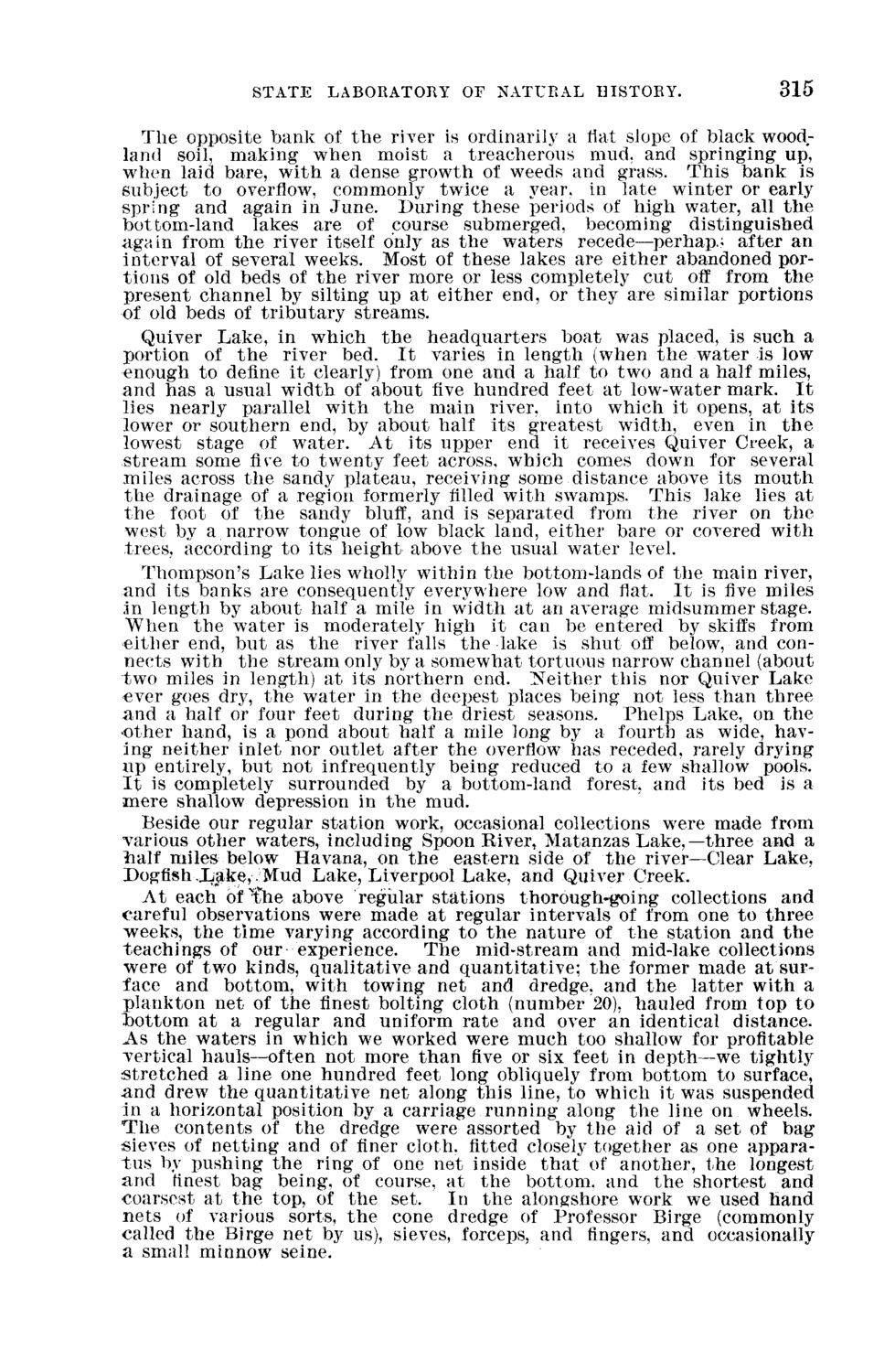| |
| |
Caption: Board of Trustees Minutes - 1894
This is a reduced-resolution page image for fast online browsing.

EXTRACTED TEXT FROM PAGE:
STATE LABORATORY OF NATURAL HISTORY. 315 The opposite bank of the river is ordinarily a flat slope of black woodland soil, making when moist a treacherous mud, and springing up, when laid bare, with a dense growth of weeds and grass. This bank is subject to overflow, commonly twice a year, in late winter or early spring and again in June. During these periods of high water, all the bottom-land lakes are of course submerged, becoming distinguished again from the river itself only as the waters recede—perhaps after an interval of several weeks. Most of these lakes are either abandoned portions of old beds of the river more or less completely cut off from the present channel by silting up at either end, or they are similar portions of old beds of tributary streams. Quiver Lake, in which the headquarters boat was placed, is such a portion of t h e river bed. I t varies in length (when the water is low enough to define it clearly) from one and a half to two and a half miles, and has a usual width of about five hundred feet at low-water mark. I t lies nearly parallel with t h e main river, into which it opens, at its lower or southern end, by about half its greatest width, even in t h e lowest stage of water. At its upper end it receives Quiver Creek, a stream some five to twenty feet across, which comes down for several miles across the sandy plateau, receiving some distance above its mouth the drainage of a region formerly filled with swamps. This lake lies at the foot of the sandy bluff, and is separated from the river on the west by a narrow tongue of low black land, either bare or covered with trees, according to its height above t h e usual water level. Thompson's Lake lies wholly within the bottom-lands of the main river, and its banks are consequently everywhere low and flat. I t is five miles in length by about half a mile in width at an average midsummer stage. When the water is moderately high it can be entered by skiffs from either end, but as the river falls the lake is shut off below, and connects with the stream only by a somewhat tortuous narrow channel (about two miles in length) at its northern end. Neither this nor Quiver Lake ever goes dry, the water in the deepest places being not less than three and a half or four feet during the driest seasons. Phelps Lake, on the other hand, is a pond about half a mile long by a fourth as wide, having neither inlet nor outlet after the overflow has receded, rarely drying up entirely, but not infrequently being reduced to a few shallow pools. I t is completely surrounded by a bottom-land forest, and its bed is a mere shallow depression in the mud. Beside our regular station work, occasional collections were made from various other waters, including Spoon River, Matanzas Lake, —three and a Iialf miles below Havana, on the eastern side of the river—Clear Lake, DogfishX^ke,, Mud Lake, Liverpool Lake, and Quiver Creek. At each of ^the above regular stations thorough-going collections and careful observations were made at regular intervals of from one to three weeks, the time varying according to the nature of the station and t h e teachings of our experience. The mid-stream and mid-lake collections were of two kinds, qualitative and quantitative; the former made at surface and bottom, with towing net and dredge, and the latter with a plankton net of the finest bolting cloth (number 20), hauled from top to bottom at a regular and uniform rate and over an identical distance. As the waters in which we worked were much too shallow for profitable vertical hauls—often not more than five or six feet in depth—we tightly stretched a line one hundred feet long obliquely from bottom to surface, and drew the quantitative net along this line, to which it was suspended in a horizontal position by a carriage running along the line on wheels. T h e contents of the dredge were assorted by the aid of a set of bag sieves of netting and of finer cloth, fitted closely together as one apparat u s by pushing the ring of one net inside t h a t of another, the longest and finest bag being, of course, at the bottom, and the shortest and coarsest at the top, of the set. In the alongshore work we used hand nets of various sorts, the cone dredge of Professor Birge (commonly called the Birge net by us), sieves, forceps, and fingers, and occasionally a small minnow seine.
| |